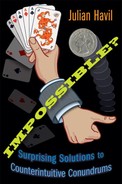Introduction
A paradox,
A most ingenious paradox!
We’ve quips and quibbles heard in flocks,
But none to beat this paradox!
The Pirates of Penzance
We begin with a classic puzzle.
Imagine a rope just long enough to wrap tightly around the equator of a perfectly spherical Earth. Now imagine that the length of the rope is increased by 1 metre and again wrapped around the Earth, supported in a regular way so that it forms an annulus. What is the size of the gap formed between the Earth and the extended rope?
The vast Earth, the tiny 1 metre—surely the rope will be in effect as tight after its extension as before it? Yet, let us perform a small calculation: in standard notation, if C = 2πr for the Earth and the original length of the rope and C + 1 = 2πR for the rope lengthened, we require the size of
![]()
The Cs have cancelled, leaving 1/2π = 0.159 . . . m ≈ 16 cm as the gap. The Earth could have been replaced by any other planet, an orange or a ping-pong ball and the result would have been the same: a fact which is hard to accept even though the reasoning is irrefutable.
In Nonplussed! we gathered together a variety of counterintuitive situations and in this sequel we chronicle eighteen more mathematical phenomena which, if allowed to do so, confound one’s reason. The criterion for inclusion has been, as it was in Nonplussed!, that, in the recent or distant past, the matter has caused the author surprise. We hope that the reader experiences surprise too, although we must once again accept the subjectivity of the reaction.
Again, probability and statistics show themselves to be fertile ground for the counterintuitive, constituting about half of the material of the book, but the remainder is again eclectic and again meant to be so. Some of the material has an interesting history and where possible we have tried to detail this, and some has far-reaching consequences, extending significantly beyond our treatment here, and we have tried to indicate this too. All-in-all, we have collected together and attempted to explain a medley of the confusing.
The mathematical level varies considerably and we have tried to arrange the chapters so that there is a progression, although this has been particularly difficult to achieve with such a collection of material. Sometimes, in order to include a result at all, it has been necessary to sidestep full mathematical rigour and to be content with what we hope is an illuminating argument, convincing if not fully complete. It is not the sole instance, but perhaps the definitive example of this is the Banach–Tarski paradox, which is utterly profound and about which research papers and books have been written; it lives in the heart of abstract mathematics but to have omitted it completely would have been a greater sin than including it, if somewhat superficially. It is utterly unbelievable. As with all the ideas we introduce, the reader can delve deeper if they desire and we have tried to include appropriate references where possible.
We hope that, as these pages are turned, the reader will be reminded of old favourites or informed of new favourites-in-waiting—and that Simon Newcomb’s observation about his tables of logarithms, which we discuss in chapter 16, will not prevail here!
